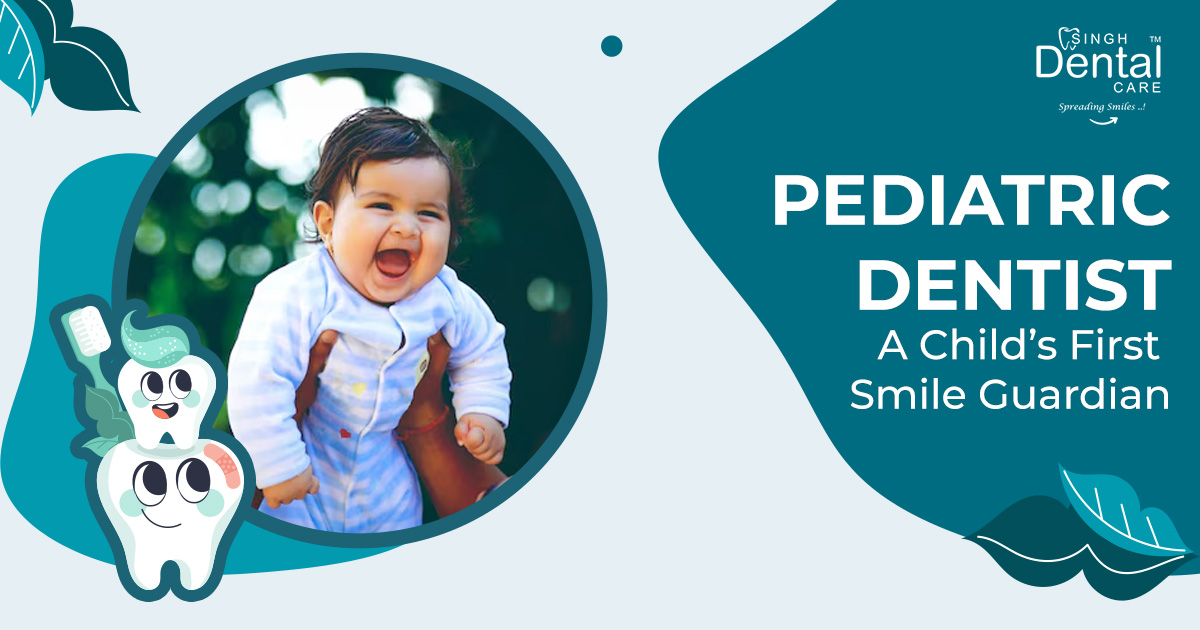
A child’s smile is precious- bright, innocent and full of joy. There is nothing more heartwarming than your child’s very first toothy grin, and ensuring its health is a priority for parents. Behind every beaming grin is a journey of oral development that needs love, attention, and expert care. At the heart of this beautiful journey stands a pediatric dentist—a dedicated professional trained to protect, guide, and nurture your child’s oral health every step of the way.
From baby teeth to braces, a pediatric dentist is more than just cavity fixers. They play a vital role in shaping your child’s dental future, making sure their journey from gummy giggles to confident smiles is smooth, healthy, and tear-free (well, mostly).
Before we dive in, let’s begin with the pediatric dentistry definition.
Pediatric dentistry is a dental specialty that on the oral health of infants, children, adolescents, and children with special needs. It goes beyond cleaning teeth—it includes behaviour management, growth tracking, preventive care, and habit counselling, and therapeutic interventions specifically tailored to the physical and psychological development of children at all different stages.
Simply put:
Pediatric dentistry = Big care for little teeth.
Unlike general dentists, a pediatric dentist is specially trained to care for children through every stage of development—emotionally and physically. Their goal? To build trust, reduce fear, and create positive dental experiences, growth and development, trauma management, sedation techniques, and communication strategies that ease dental anxiety.
A pediatric dentist understands how to manage teething toddlers, restless school-goers, and anxious teens—all with compassion.
It’s not just about cleaning and fixing teeth. It’s about understanding a child’s unique physical and emotional development, and creating care that fits just right. Pediatric dentists:
Teach kids how to brush like a boss
Catch problems early (like bite issues or thumb sucking)
Make dentist visits fun instead of scary
Work with kids who have special healthcare needs
Helping parents support healthy routines at home
A pediatric dentist is a dental professional who undergoes additional training after dental school to focus exclusively on child oral care. Their expertise lies not only in treating cavities but also in early detection of dental issues, habit counseling, trauma management, and creating a dental-friendly experience.
They’re the smile protectors, tooth teachers, and emotional supporters of little ones in the dental chair.
Pediatric dentists:
They know how to:


You might also come across:
The need for pediatric dentists is greater than ever before. According to the CDC, tooth decay is the most common chronic childhood disease—five times more common than asthma. Left untreated, dental problems can interfere with eating, speaking, learning, and overall development. Around 51% of children aged 6-11 years have cavities and 1 in every 10 children suffers from dental pain making it hard to chew and eat healthy foods.
Pediatric dentists are key to:
Their clinics are designed with children in mind—colorful walls, smaller dental chairs, and a welcoming environment that turns fear into fun
They also emphasize preventive dentistry, using tools like:
More often than not, parents are referred to a pediatric dentist when their child’s tooth trouble is out of hand and may require invasive treatments. While a Pediatric dentist is well equipped to manage them as well, there are ways offered by contemporary dentistry which can prevent those problems from ever happening in the first place. Early dental visits build trust and lay the foundation for lifelong oral health.
Keep in mind the Rule of 7 in Pediatric Dentistry:


The AAPD recommends that a child should visit a dentist by age 1 or within 6 months of the eruption of the first tooth—whichever comes first. A child’s first dental visit with a pediatric dentist should be easy-going, positive, and educational.
The goals:
Familiarize the child with the dental clinic
Teach parents about brushing and diet
Identify potential issues early
Pediatric dentists often use play-based communication, puppets, or storybooks to explain procedures. This builds a strong, trusting relationship that grows with the child.
Tip: Make the first visit fun. Choose a morning appointment when the child is well-rested and avoid using words like “pain” or “hurt.”
It’s just a fancy word for pediatric dental care.
Paedo = child
Odontic = teeth
Together, paedodontics means “child’s dental science”—the art and science a pediatric dentist practices every day.
Yes, general dentists can treat kids… but pediatric dentists are the true pros at it.
Here’s why:
Feature | General Dentist | Pediatric Dentist |
Patient age | All ages | Kids only |
Training | Basic dental degree (5 years) | Basic dental degree (5 years) + 3 years specialized training |
Clinic setup | Adult-oriented | Child-friendly |
Behavior management | Limited | Advanced techniques |
Environment | Adult-Focused | Kid-friendly, Calming |
It’s like comparing a general doctor to a pediatrician—both are awesome, but one’s specialized for tiny humans!
A pediatric dentist is much more than a tooth doctor for kids—they’re your partner in your child’s health journey. They are confidence builders, habit shapers, and lifelong smile supporters.
They turn scary drills into silly games, transform dental visits into adventures, and help children grow up without dental fear. They are the true guardians of your child’s first smile—and every one after that.As guardians of children’s first smiles, a pediatric dentist leave a lasting impact—one that goes far beyond teeth.
So the next time your little one flashes a toothy grin, remember—behind that bright smile might just be the magic touch of a pediatric dentist.
Dr. Navneet Kaur
Consultant Pediatric Dentist
References
American Academy of Pediatric Dentistry (AAPD). (2023). Definition of pediatric dentistry. https://www.aapd.org
McDonald, R. E., Avery, D. R., & Dean, J. A. (2011). Dentistry for the Child and Adolescent. Mosby.
Wright, G. Z., Kupietzky, A., & Lee, J. (2014). Behavior Management in Dentistry for Children. Wiley-Blackwell.
Centers for Disease Control and Prevention (CDC). (2023). Children’s Oral Health. https://www.cdc.gov
National Institute of Dental and Craniofacial Research (NIDCR). (2022). Children’s Oral Health. https://www.nidcr.nih.gov
WhatsApp us